Comprehensive Evaluation of Global Precipitation Measurement Mission (GPM) IMERG Precipitation Products over Mainland China
Abstract
:1. Introduction
2. Materials and Methods
2.1. Study Area
2.2. Data Resources
2.2.1. Rain Gauge Data
2.2.2. Satellite Datasets
2.3. Study Methods
2.3.1. Statistical Indicators
- Correlation coefficient (CC)
- 2.
- Root-mean-square error (RMSE)
- 3.
- Relative bias (BIAS)
2.3.2. Detection Index
- Probability of detection (POD)
- 2.
- False alarm ratio (FAR)
- 3.
- Critical success index (CSI)
- 4.
- BIAS (B)
- 5.
- Equitable threat score (ETS)
3. Results
3.1. Comparative Analysis of Three Types of GPM IMERG Products
3.1.1. CC
3.1.2. RMSE
3.1.3. BIAS
3.1.4. ETS
3.2. Deeper Evaluation of the Final Run
3.2.1. POD
3.2.2. FAR
3.2.3. CSI
3.2.4. BIAS
3.3. Effect of the Altitude on the Precipitation Inversion Accuracy
4. Discussion
5. Conclusions
- Based on the evaluation of the IMERG Early, Late, and Final Runs using the CC, RMSE, BIAS, and ETS, the CC, and BIAS values of the products in eastern China are better than those in western China, whereas the RMSE increases from northwest to southeast, with a peak in Guangdong, Guangxi, and Hainan. Regarding the high latitudes in Northeast China, the IMERG products show a high correlation and low deviation in several areas. Therefore, IMERG products can be used in China’s high-latitude areas, but they are inferior to non-real-time applications (such as water resources management and hydrology modeling) at low latitudes. The IMERG Early and Late Run (near real-time products) can be used for real-time applications such as flood forecasting in low-latitude subtropical humid areas in southeast China. In high-latitude areas, the applicability of near real-time Early and Late run products is low, but they have a real-time application potential and must be further explored. The reasons for the poor performance in northwest China are the complex terrain, arid climate conditions, and significant interference of wind and snow regarding satellite precipitation inversion, resulting in uncertainty in the evaluation results. In addition, although the IMERG Late Run contains more remote sensing information and has a longer delay, its performance is only slightly better than the IMERG Early Run. Therefore, it is recommended to first consider the IMERG Early Run product with a shorter delay time (~4 h).
- When using the ETS index to evaluate the accuracy of satellite products under various levels of precipitation, better results are obtained for “producing rainfall” and “light rain” in most areas of Tibet, Eastern Yunnan, Eastern Sichuan, Qinghai, and southern Gansu. With the increase in the precipitation magnitude, the evaluation results gradually worsen. Regarding the ETS scores of moderate rain, heavy rain, and rainstorm, high values can be observed in the eastern and southern coastal areas. Overall, except for individual regions, the performance of the Late Run is slightly better than the Early Run. The improvement of the Final Run is the most notable.
- POD, FAR, CSI, and B were used to analyze the estimation performance of the Final Run. The results show that the performance in South and East China with a humid monsoon climate is better, whereas it is worse in the western drought region with a high altitude. On the one hand, topographical and climatic conditions significantly affect the satellite estimation results. However, the performance is related to the algorithm of the Final Run, which aims to correct the deviation between the GPM satellite detection results and the GPCC precipitation datasets. Therefore, when the Final Run product is used for the evaluation, the results are also affected by the number of ground reference stations. In addition, the Final Run has a strong ability to detect light rain, but it will overestimate it. This may be summarized as the following reasons: (1) the over-correction of the satellite inversion algorithm, which misinterprets several non-rainfall events as light rain events; and (2) light rain is easy to be missed at ground observation stations, which will affect the evaluation results. With the increase in precipitation, the detection ability decreases and underestimation occurs. Generally, it is necessary to improve the detection ability of the Final Run for heavy rain and rainstorms and strengthen the detection of precipitation in the western region.
- Based on the overall performance of the Final Run, the evaluation of the eastern region was better than those of the western region. To reveal the reason for this difference, the effect of the altitude was studied. Based on the results, the performance of the Final Run is excellent regarding the detection of light rain in high-altitude areas, but it is poor in low-altitude regions. Regarding moderate and heavy rain, the performance of the Final Run is better in low-altitude areas in the east and poor in the west. Optimal values were mainly obtained in the eastern coastal areas. The results are related to the principle of precipitation detection by the satellite. The satellite detects precipitation information on the cloud top by using microwave and infrared sensors. The estimated precipitation experiences evaporation and air resistance dissipation before reaching the ground. As the western high-altitude area is close to the cloud top, the loss is smaller when light rain is detected, and the detection result is relatively accurate. Evaporation insignificantly affects moderate and heavy rain; a large amount of precipitation occurs in the eastern region. Based on various factors, the satellite has a better detection ability in the eastern and southern coastal plain areas.
- The comparison of various indicators shows that IMERG products perform poorly in northwest China, which may be related to local climate conditions. The northwestern region is relatively arid, and evaporation is strong. Not all liquid water observed in the atmospheric profile represents precipitation. The precipitation retrieved by the satellite is based on the cloud structure and its algorithm and model may not fully consider the evaporation level in these areas. In addition, due to the strong evaporation in arid areas, parts of the liquid water evaporate during landing, leading to errors in the estimation of precipitation in arid areas.
- Based on this research, the detection ability of light rain of GPM IMERG precipitation products in western high-altitude areas is better than that in most eastern areas, but contrasts that of moderate and heavy rain. However, the detection ability has not been evaluated on a seasonal scale. Such an evaluation should be conducted in future research to better understand the characteristics of GPM products towards various seasons.
- In this study, daily precipitation data were analyzed. The GPM IMERG 30 min precipitation data should be evaluated in future research with more indices, in order to get more comprehensive results.
- The evaluation results at the national scale may not apply to the watershed scale, such as multi-terrain rainfall and extreme precipitation in the Sichuan Basin. Therefore, it is necessary to conduct more in-depth research on watershed division and altitude factors, especially the districts with unique topographic conditions.
Author Contributions
Funding
Acknowledgments
Conflicts of Interest
References
- Boluwade, A.; Stadnyk, T.; Fortin, V.; Roy, G. Assimilation of Precipitation Estimates from the Integrated Multisatellite Retrievals for GPM (IMERG, early Run) in the Canadian Precipitation Analysis (CaPA). J. Hydrol. Reg. Stud. 2017, 14, 10–22. [Google Scholar] [CrossRef]
- Zhao, C.; Huang, Y.; Li, Z.; Chen, M. Drought Monitoring of Southwestern China Using Insufficient GRACE Data for the Long-Term Mean Reference Frame under Global Change. J. Clim. 2018, 31, 6897–6911. [Google Scholar] [CrossRef]
- Kucera, P.A.; Ebert, E.E.; Turk, F.J.; Levizzani, V.; Kirschbaum, D.; Tapiador, F.J.; Loew, A.; Borsche, M. Precipitation from Space: Advancing Earth System Science. Bull. Am. Meteorol. Soc. 2013, 94, 365–375. [Google Scholar] [CrossRef]
- Homsi, R.; Shiru, M.S.; Shahid, S.; Ismail, T.; Bin Harun, S.; Al-Ansari, N.; Chau, K.-W.; Yaseen, Z.M. Precipitation projection using a CMIP5 GCM ensemble model: A regional investigation of Syria. Eng. Appl. Comput. Fluid Mech. 2020, 14, 90–106. [Google Scholar] [CrossRef]
- Rozante, J.R.; Vila, D.A.; Chiquetto, J.B.; Fernandes, A.D.A.; Alvim, D.S. Evaluation of TRMM/GPM Blended Daily Products over Brazil. Remote Sens. 2018, 10, 882. [Google Scholar] [CrossRef] [Green Version]
- Sharafati, A.; Pezeshki, E. A strategy to assess the uncertainty of a climate change impact on extreme hydrological events in the semi-arid Dehbar catchment in Iran. Theor. Appl. Clim. 2020, 139, 389–402. [Google Scholar] [CrossRef]
- Yan, J.; Bárdossy, A. Short time precipitation estimation using weather radar and surface observations: With rainfall displacement information integrated in a stochastic manner. J. Hydrol. 2019, 574, 672–682. [Google Scholar] [CrossRef]
- Mahmoud, M.T.; Hamouda, M.A.; Mohamed, M.M. Spatiotemporal evaluation of the GPM satellite precipitation products over the United Arab Emirates. Atmos. Res. 2019, 219, 200–212. [Google Scholar] [CrossRef]
- Ebrahimi, S.; Chen, C.; Chen, Q.; Zhang, Y.; Ma, N.; Zaman, Q. Effects of temporal scales and space mismatches on the TRMM 3B42 v7 precipitation product in a remote mountainous area. Hydrol. Process. 2017, 31, 4315–4327. [Google Scholar] [CrossRef]
- Fang, J.; Yang, W.; Luan, Y.; Du, J.; Lin, A.; Zhao, L. Evaluation of the TRMM 3B42 and GPM IMERG products for extreme precipitation analysis over China. Atmos. Res. 2019, 223, 24–38. [Google Scholar] [CrossRef]
- Wang, X.; Ding, Y.; Zhao, C.; Wang, J. Similarities and improvements of GPM IMERG upon TRMM 3B42 precipitation product under complex topographic and climatic conditions over Hexi region, Northeastern Tibetan Plateau. Atmos. Res. 2019, 218, 347–363. [Google Scholar] [CrossRef]
- Yuan, F.; Wang, B.; Shi, C.; Cui, W.; Zhao, C.; Liu, Y.; Ren, L.; Zhang, L.; Zhu, Y.; Chen, T.; et al. Evaluation of hydrological utility of IMERG Final run V05 and TMPA 3B42V7 satellite precipitation products in the Yellow River source region, China. J. Hydrol. 2018, 567, 696–711. [Google Scholar] [CrossRef]
- Gaona, M.F.R.; Overeem, A.; Leijnse, H.; Uijlenhoet, R. First-year evaluation of GPM rainfall over the Netherlands: IMERG day 1 final run (VO3D). J. Hydrometeorol. 2016, 17, 2799–2814. [Google Scholar] [CrossRef]
- Thakur, M.K.; Kumar, T.V.L.; Narayanan, M.S.; Kundeti, K.R.; Barbosa, H. Analytical study of the performance of the IMERG over the Indian landmass. Meteorol. Appl. 2020, 27, e1908. [Google Scholar] [CrossRef]
- Anjum, M.N.; Ding, Y.; Shangguan, D.; Ahmad, I.; Ijaz, M.W.; Farid, H.U.; Yagoub, Y.E.; Zaman, M.; Adnan, M. Performance evaluation of latest integrated multi-satellite retrievals for Global Precipitation Measurement (IMERG) over the northern highlands of Pakistan. Atmos. Res. 2018, 205, 134–146. [Google Scholar] [CrossRef]
- Asong, Z.E.; Razavi, S.; Wheater, H.S.; Wong, J.S. Evaluation of Integrated Multisatellite Retrievals for GPM (IMERG) over Southern Canada against Ground Precipitation Observations: A Preliminary Assessment. J. Hydrometeorol. 2017, 18, 1033–1050. [Google Scholar] [CrossRef]
- Yu, C.; Hu, D.; Di, Y.; Wang, Y. Performance evaluation of IMERG precipitation products during typhoon Lekima (2019). J. Hydrol. 2021, 597, 126307. [Google Scholar] [CrossRef]
- Yang, M.; Liu, G.; Chen, T.; Chen, Y.; Xia, C. Evaluation of GPM IMERG precipitation products with the point rain gauge records over Sichuan, China. Atmos. Res. 2020, 246, 105101. [Google Scholar] [CrossRef]
- Caracciolo, D.; Francipane, A.; Viola, F.; Noto, L.V.; Deidda, R. Performances of GPM satellite precipitation over the two major Mediterranean islands. Atmos. Res. 2018, 213, 309–322. [Google Scholar] [CrossRef] [Green Version]
- Su, J.; Lü, H.; Zhu, Y.; Cui, Y.; Wang, X. Evaluating the hydrological utility of latest IMERG products over the Upper Huaihe River Basin, China. Atmos. Res. 2019, 225, 17–29. [Google Scholar] [CrossRef]
- Guo, H.; Chen, S.; Bao, A.; Behrangi, A.; Hong, Y.; Ndayisaba, F.; Hu, J.; Stepanian, P.M. Early assessment of Integrated Multi-satellite Retrievals for Global Precipitation Measurement over China. Atmos. Res. 2016, 176–177, 121–133. [Google Scholar] [CrossRef]
- Zhao, H.; Yang, B.; Yang, S.; Huang, Y.; Dong, G.; Bai, J.; Wang, Z. Systematical estimation of GPM-based global satellite mapping of precipitation products over China. Atmos. Res. 2018, 201, 206–217. [Google Scholar] [CrossRef]
- Jiang, L.; Bauer-Gottwein, P. How do GPM IMERG precipitation estimates perform as hydrological model forcing? Evaluation for 300 catchments across Mainland China. J. Hydrol. 2019, 572, 486–500. [Google Scholar] [CrossRef]
- Liao, R.; Zhang, D.; Shen, Y. Validation of Six Satellite-Derived Rainfall Estimates over China. Meteorol. Mon. 2015, 8, 971–978. [Google Scholar]
- Huang, W.-R.; Chang, Y.-H.; Liu, P.-Y. Assessment of IMERG precipitation over Taiwan at multiple timescales. Atmos. Res. 2018, 214, 239–249. [Google Scholar] [CrossRef]
- Arshad, M.; Ma, X.; Yin, J.; Ullah, W.; Ali, G.; Ullah, S.; Liu, M.; Shahzaman, M.; Ullah, I. Evaluation of GPM-IMERG and TRMM-3B42 precipitation products over Pakistan. Atmos. Res. 2021, 249, 105341. [Google Scholar] [CrossRef]
- Wang, Z.; Zhong, R.; Lai, C.; Chen, J. Evaluation of the GPM IMERG satellite-based precipitation products and the hydrological utility. Atmos. Res. 2017, 196, 151–163. [Google Scholar] [CrossRef]
- Tan, M.L.; Santo, H. Comparison of GPM IMERG, TMPA 3B42 and PERSIANN-CDR satellite precipitation products over Malaysia. Atmos. Res. 2018, 202, 63–76. [Google Scholar] [CrossRef]
- Jiang, S.-H.; Zhou, M.; Ren, L.-L.; Cheng, X.-R.; Zhang, P.-J. Evaluation of latest TMPA and CMORPH satellite precipitation products over Yellow River Basin. Water Sci. Eng. 2016, 9, 87–96. [Google Scholar] [CrossRef] [Green Version]
- Su, X.; Yuan, H.; Zhu, Y. A Comparative Study of Four Objective Quantitative Precipitation Forecast Calibration Methods. Acta Meteorol. Sin. 2021, 79, 132–149. [Google Scholar]
- Cheng, Y.; Guo, Y.; Qi, P.; Wan, N.; Lai, X. Analysis of Accuracy of GPM IMERG Precipitation Data in Chaohu Basin. Res. Soil Water Conserv. 2020, 27, 188–193. [Google Scholar]
- Wang, W.Z.; Huang, D.; Liu, H.W.; Ma, T.; Wang, H. Applicability Evaluation of GPM IMERG Satellite Precipitation Products in the Upper Reaches of Huaihe River Basin. Water Resour. Power 2020, 38. Available online: https://r.cnki.net/kcms/detail/detail.aspx?filename=SDNY202008001&dbcode=QTZT_CJFD&dbname=CJFDLAST2020&v= (accessed on 24 November 2021).
- Wu, Y.; Zhang, Z.; Jin, Q.; Huang, Y. Precision Estimation of GPM Satellite Precipitation Products in the Yangtze River Basin. Yangtze River 2019, 50, 77–85. [Google Scholar] [CrossRef]
- Hussain, Y.; Satgé, F.; Hussain, M.B.; Martinez-Carvajal, H.; Bonnet, M.-P.; Cárdenas-Soto, M.; Roig, H.L.; Akhter, G. Performance of CMORPH, TMPA, and PERSIANN rainfall datasets over plain, mountainous, and glacial regions of Pakistan. Theor. Appl. Clim. 2018, 131, 1119–1132. [Google Scholar] [CrossRef]
- Li, X.; Sungmin, O.; Wang, N.; Liu, L.; Huang, Y. Evaluation of the GPM IMERG V06 products for light rain over Mainland China. Atmos. Res. 2021, 253, 105510. [Google Scholar] [CrossRef]
- Lu, X.; Tang, G.; Wang, X.; Liu, Y.; Jia, L.; Xie, G.; Li, S.; Zhang, Y. Correcting GPM IMERG precipitation data over the Tianshan Mountains in China. J. Hydrol. 2019, 575, 1239–1252. [Google Scholar] [CrossRef]
- Zeng, S.; Yong, B. Evaluation of the GPM-based IMERG and GSMaP precipitation estimates over the Sichuan region. Acta Geogr. Sin. 2019, 74, 1305–1318. [Google Scholar]
- Chen, H.; Yong, B. Comparison Analysis of Six Purely Satellite-derived Global Precipitation Estimates. J. Hydrol. 2020, 581, 124376. [Google Scholar] [CrossRef]
- Tian, F.; Hou, S.; Yang, L.; Hu, H.; Hou, A. How Does the Evaluation of the GPM IMERG Rainfall Product Depend on Gauge Density and Rainfall Intensity? J. Hydrometeorol. 2018, 19, 339–349. [Google Scholar] [CrossRef]
- Iqbal, M.F.; Athar, H. Validation of satellite based precipitation over diverse topography of Pakistan. Atmos. Res. 2018, 201, 247–260. [Google Scholar] [CrossRef]
- Tang, G.; Zeng, Z.; Long, D.; Guo, X.; Yong, B.; Zhang, W.; Hong, Y. Statistical and Hydrological Comparisons between TRMM and GPM Level-3 Products over a Midlatitude Basin: Is Day-1 IMERG a Good Successor for TMPA 3B42V7? J. Hydrometeorol. 2016, 17, 121–137. [Google Scholar] [CrossRef]
- Li, F.; Kong, Y.; Gao, Q. Evaluation of GPM/IMERG Products in Southern Shandong. Meteorol. Sci. Technol. 2020, 48, 474–481. [Google Scholar]
- Tang, G.; Clark, M.P.; Papalexiou, S.M.; Ma, Z.; Hong, Y. Have satellite precipitation products improved over last two decades? A comprehensive comparison of GPM IMERG with nine satellite and reanalysis datasets. Remote Sens. Environ. 2020, 240, 111697. [Google Scholar] [CrossRef]
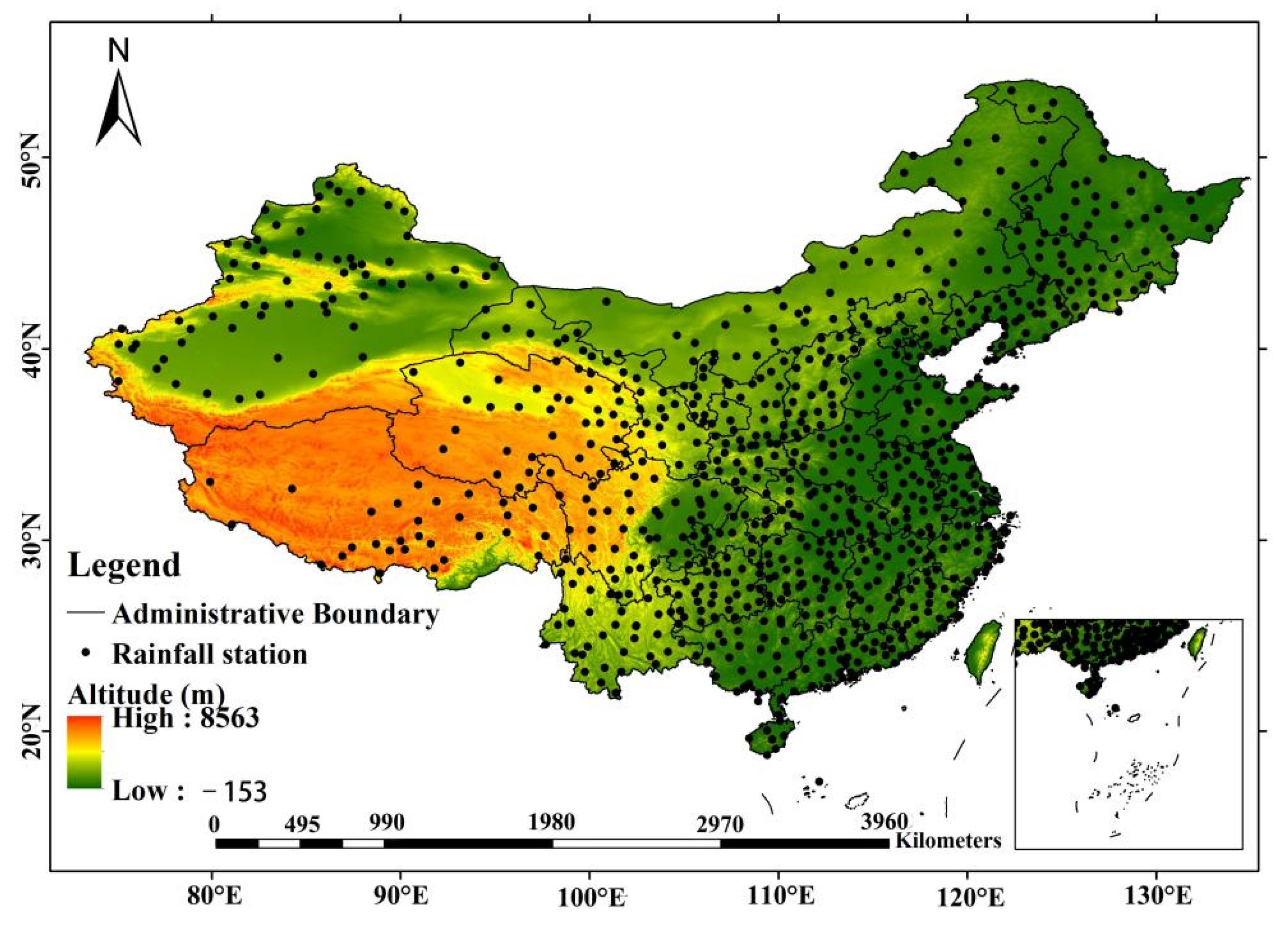
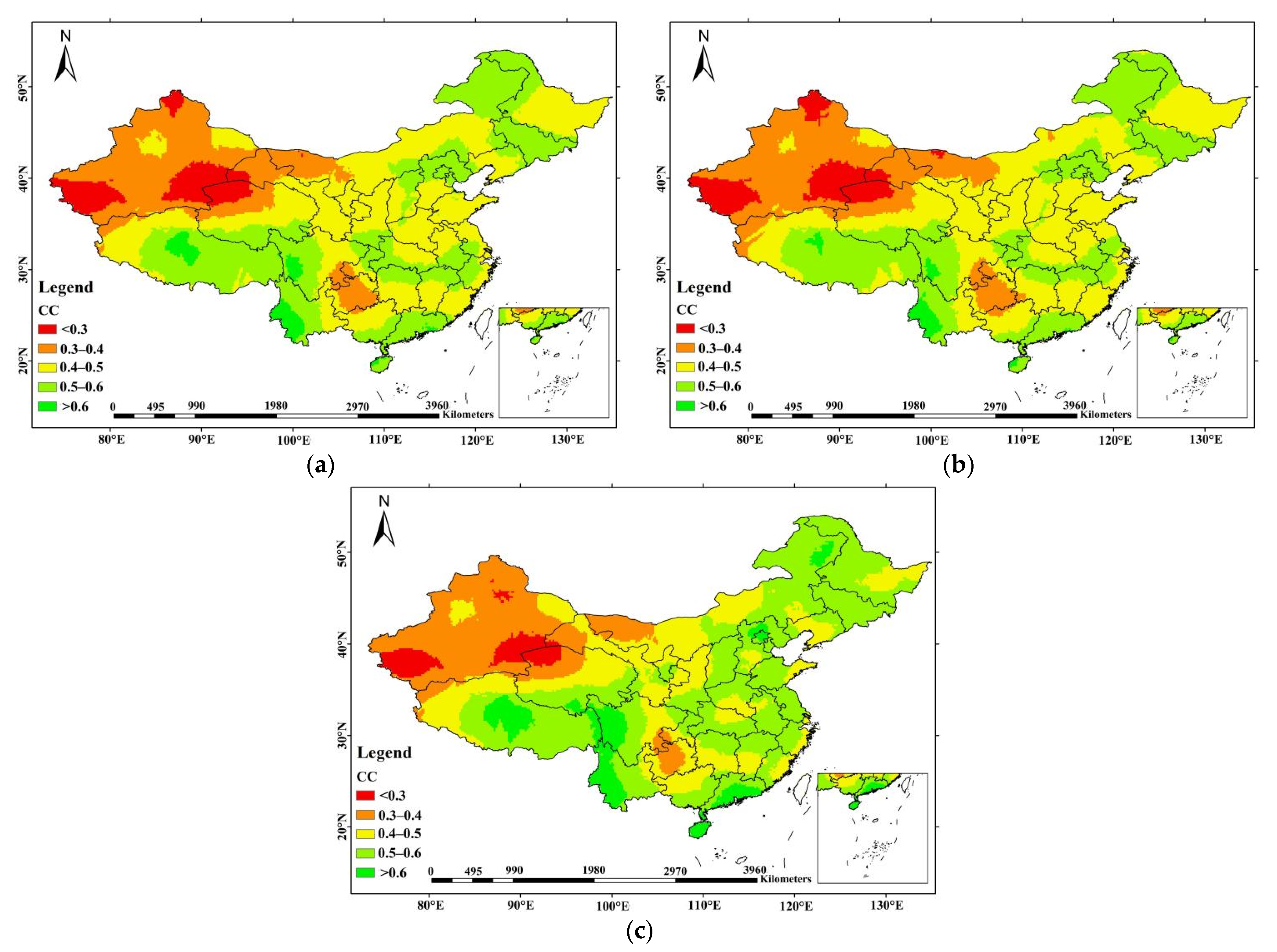


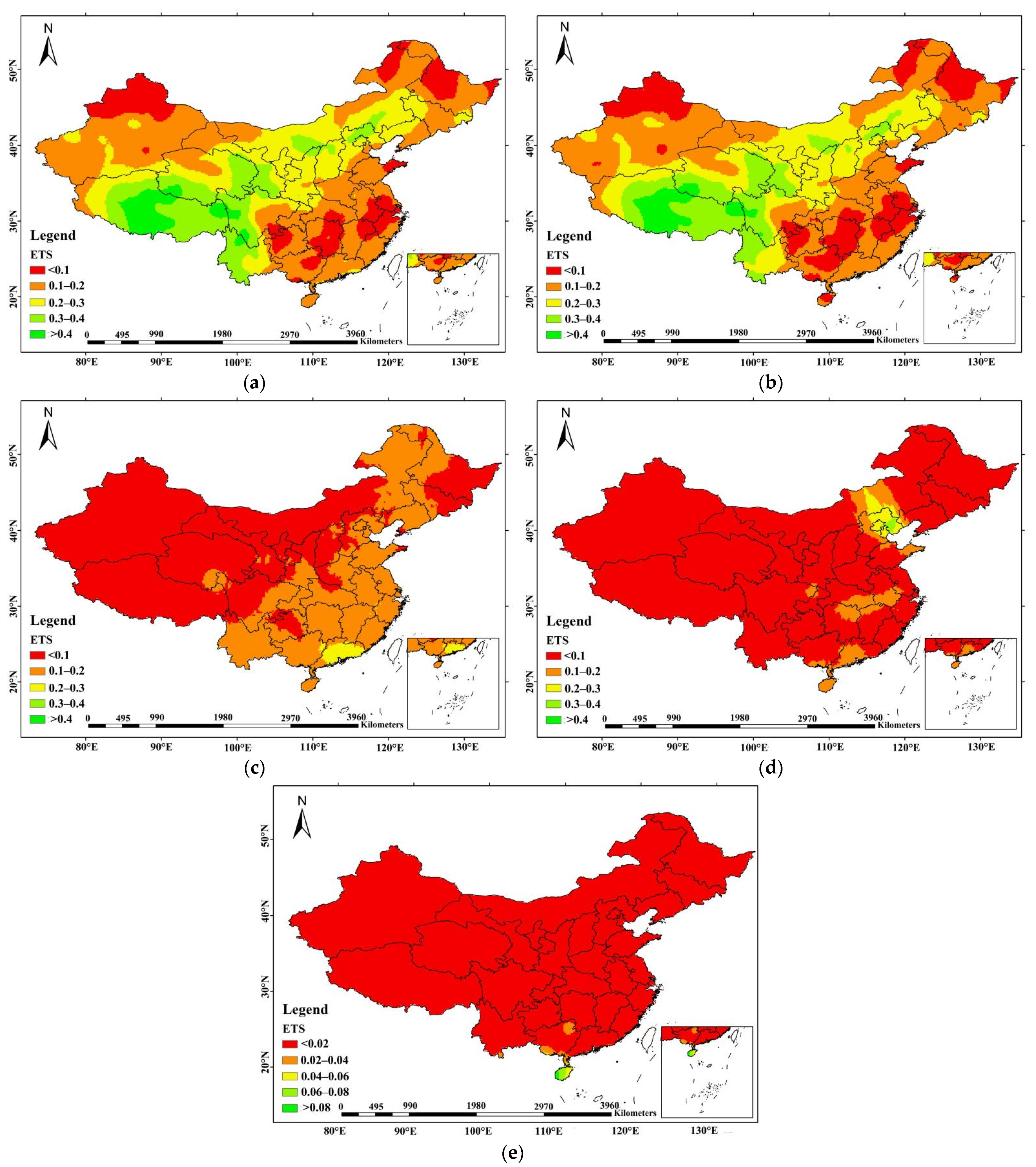
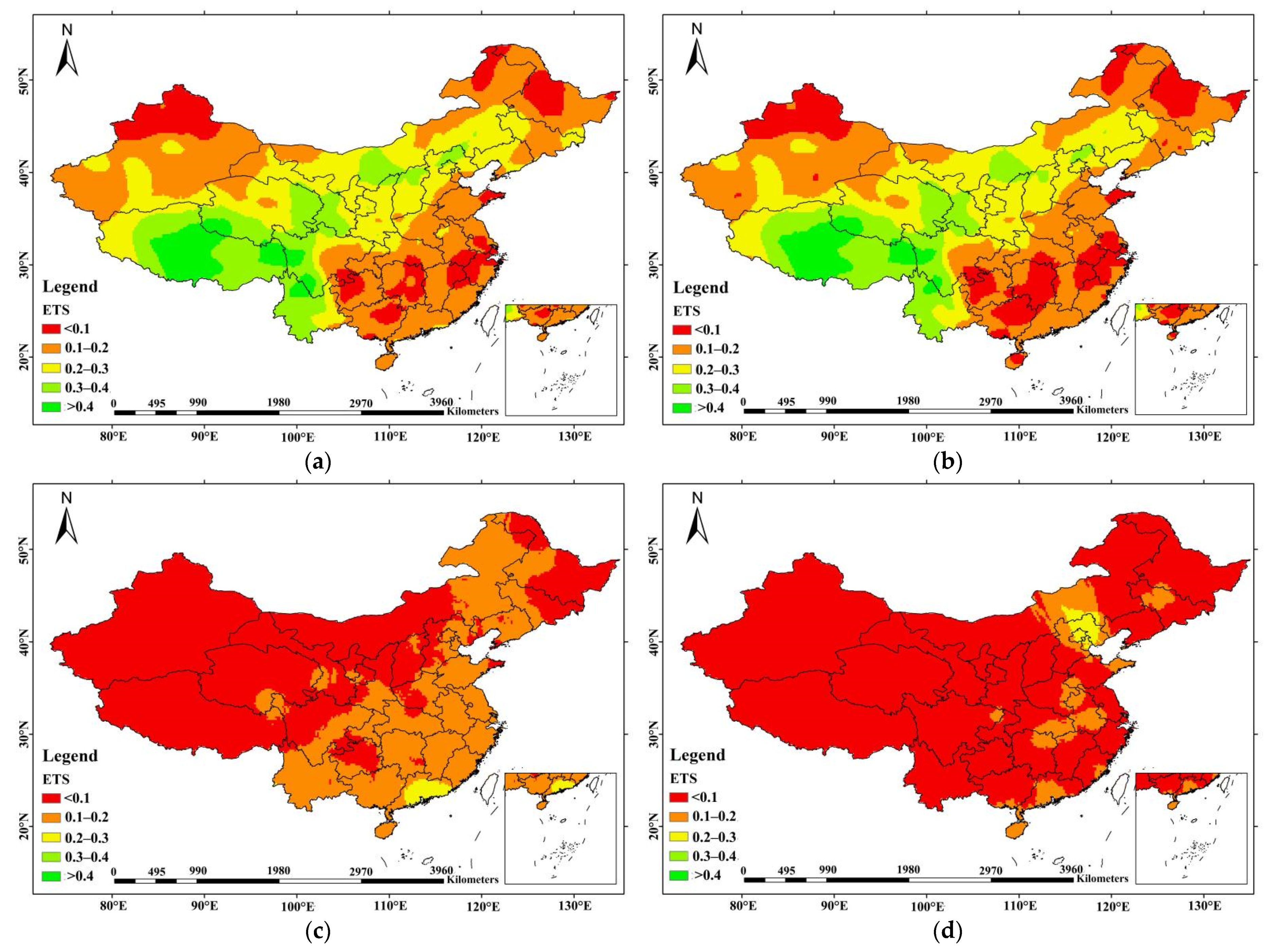
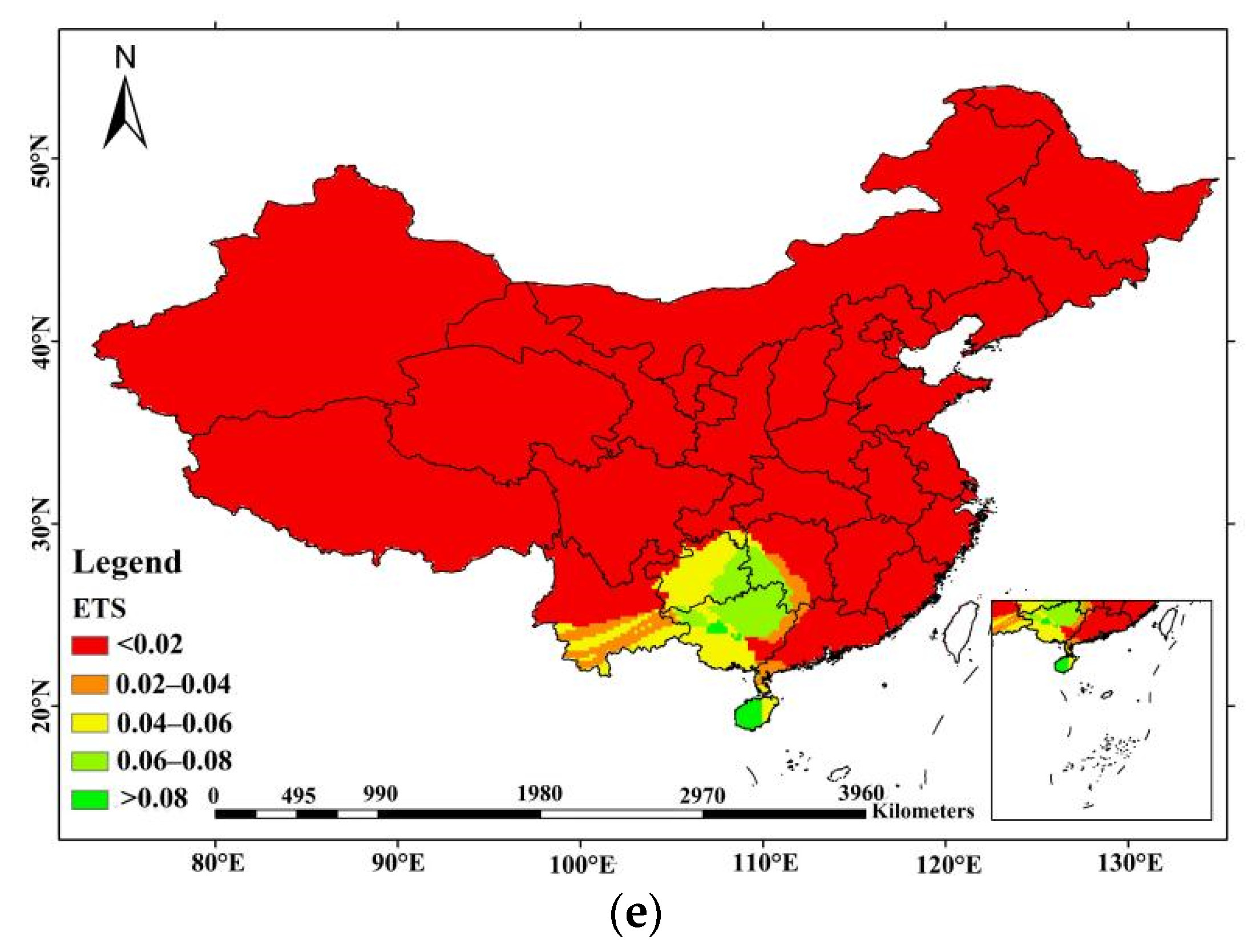

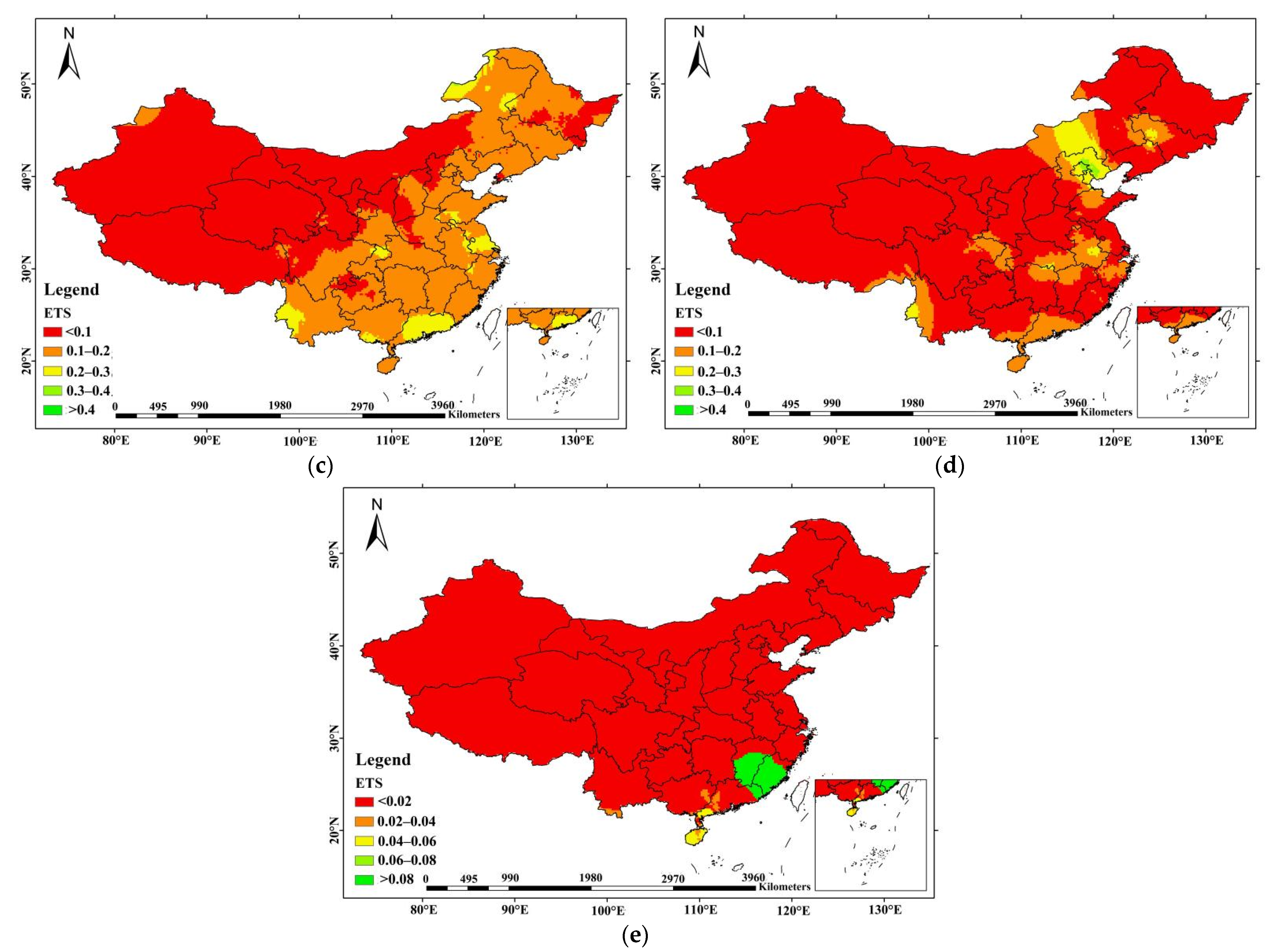
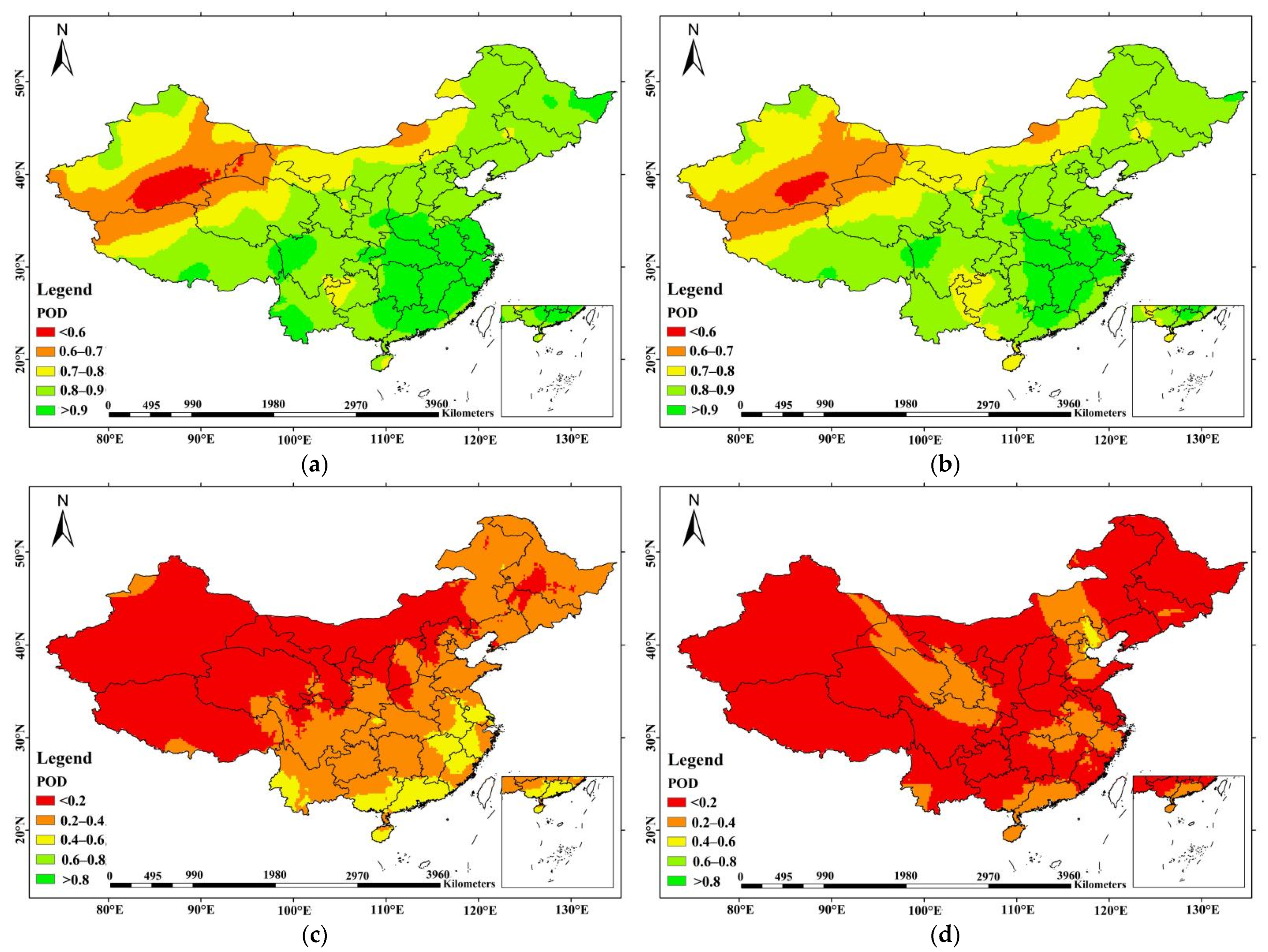
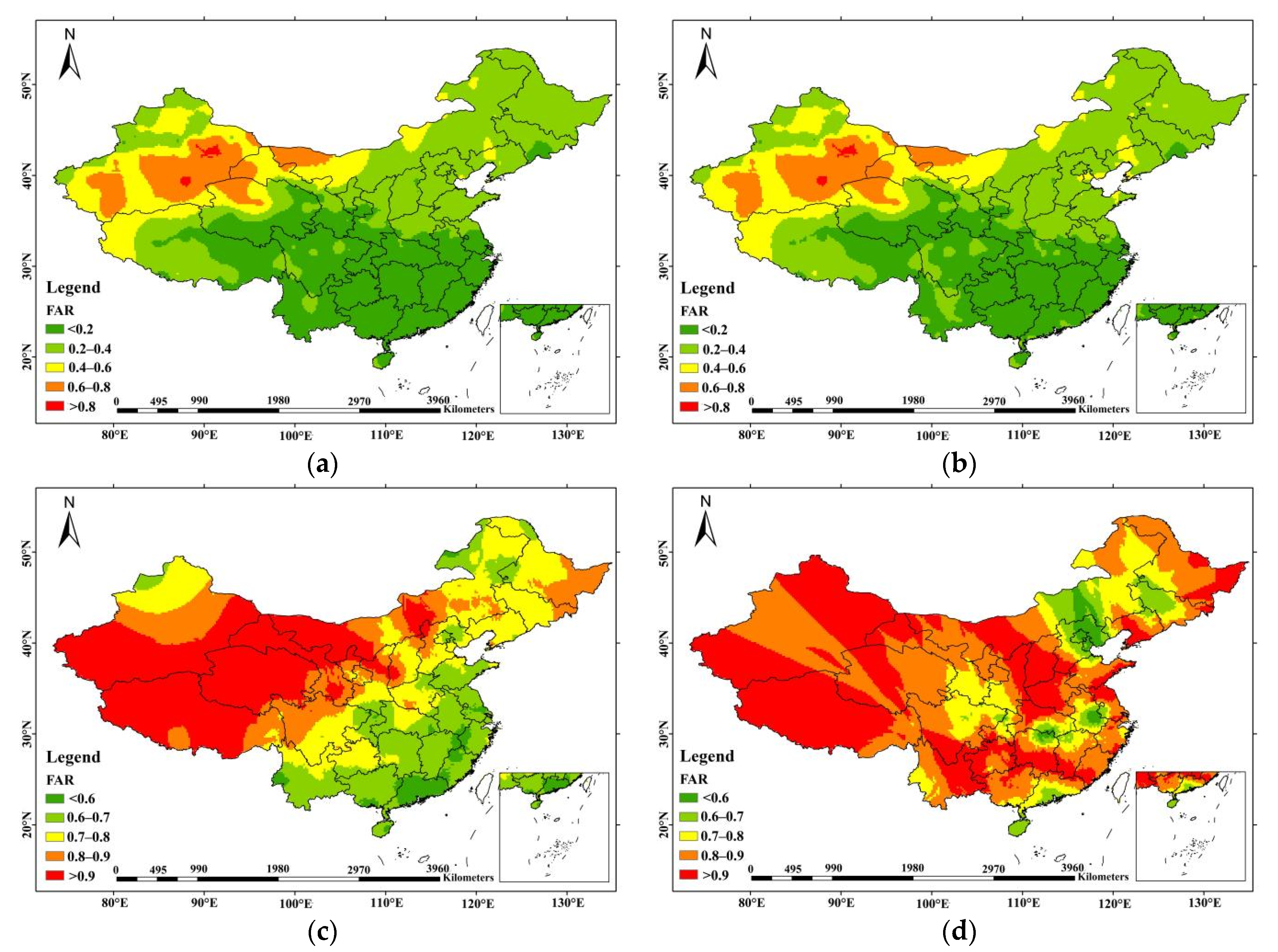
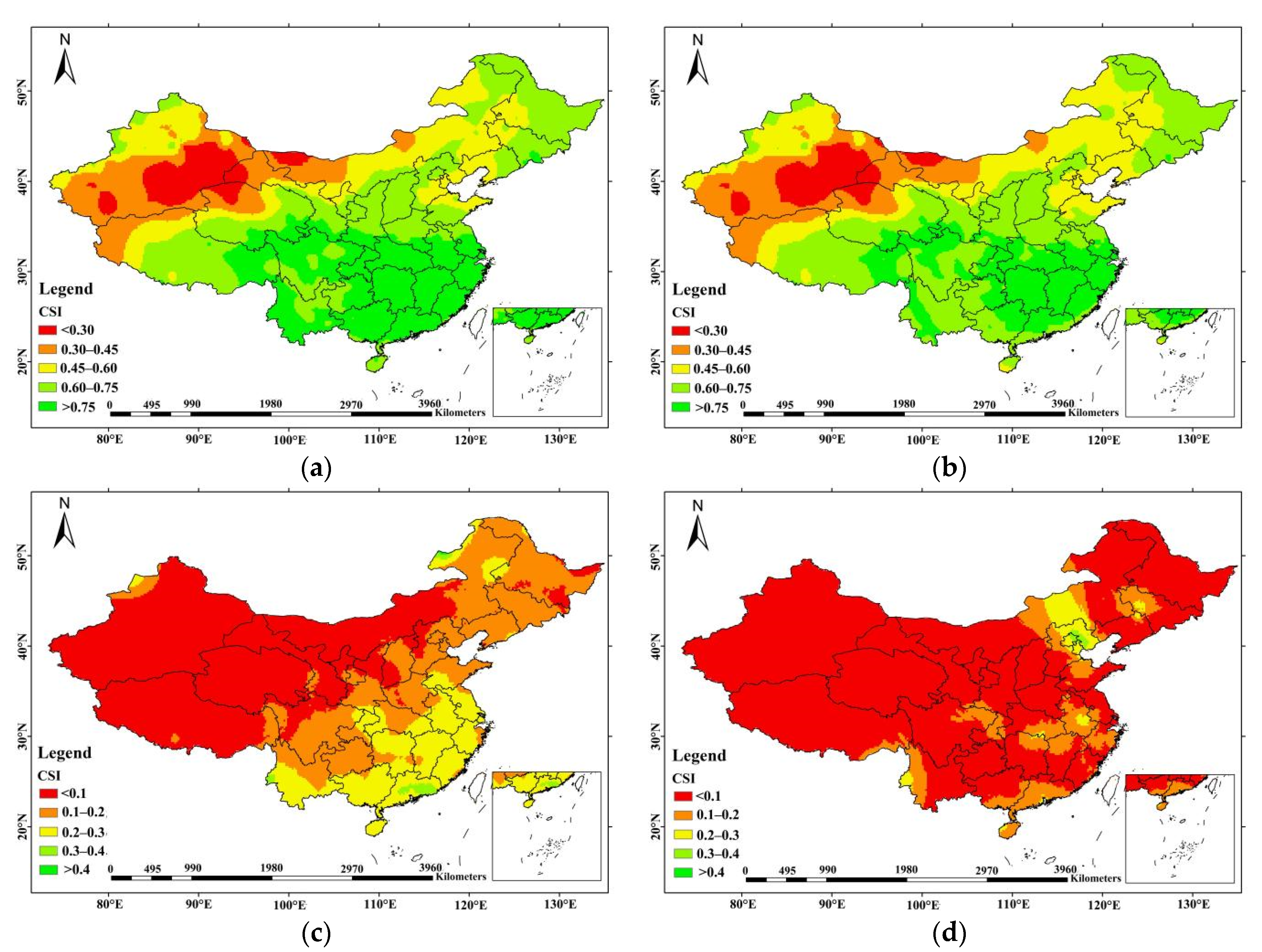
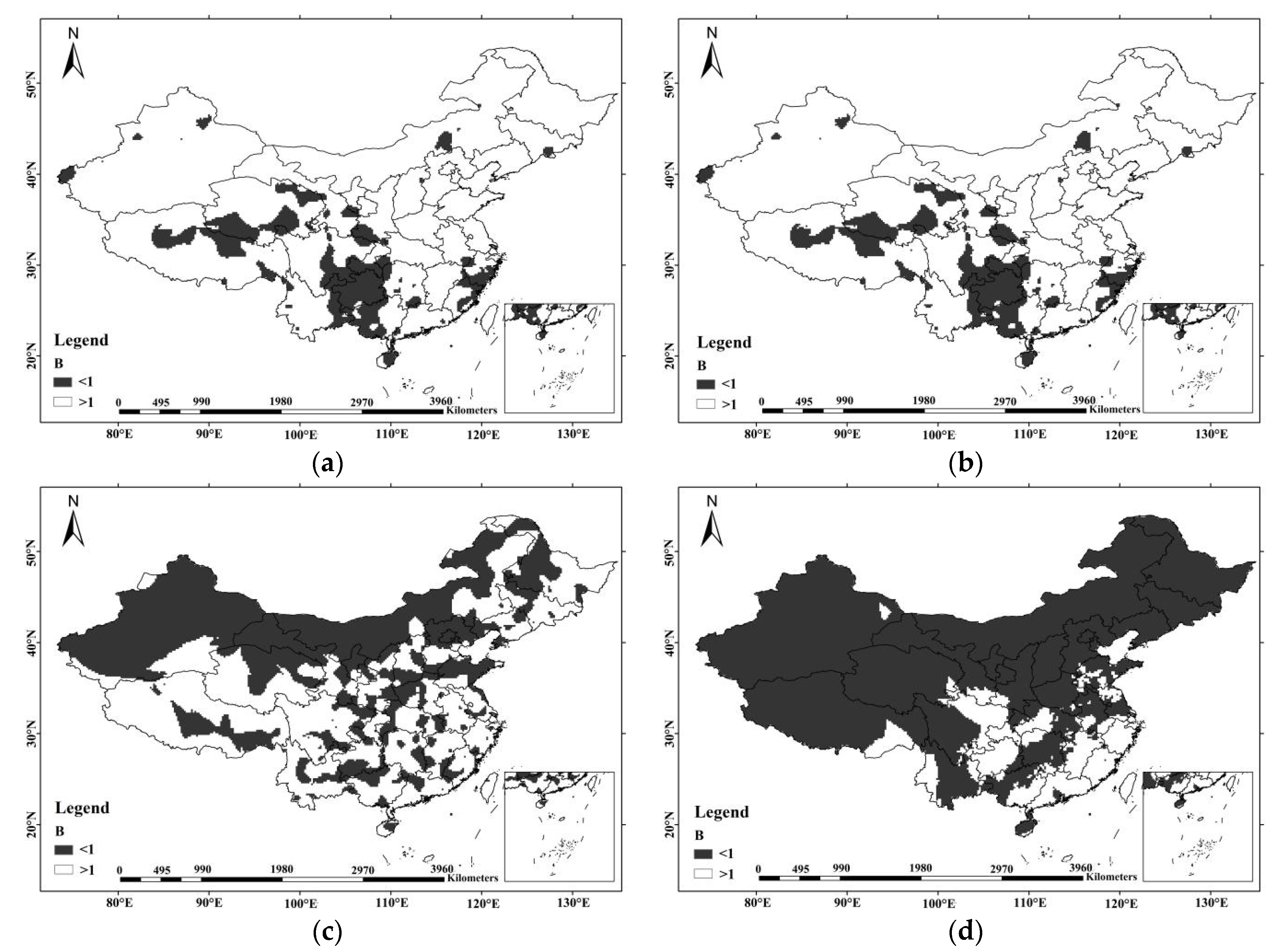

Publisher’s Note: MDPI stays neutral with regard to jurisdictional claims in published maps and institutional affiliations. |
© 2021 by the authors. Licensee MDPI, Basel, Switzerland. This article is an open access article distributed under the terms and conditions of the Creative Commons Attribution (CC BY) license (https://creativecommons.org/licenses/by/4.0/).
Share and Cite
Nan, L.; Yang, M.; Wang, H.; Xiang, Z.; Hao, S. Comprehensive Evaluation of Global Precipitation Measurement Mission (GPM) IMERG Precipitation Products over Mainland China. Water 2021, 13, 3381. https://doi.org/10.3390/w13233381
Nan L, Yang M, Wang H, Xiang Z, Hao S. Comprehensive Evaluation of Global Precipitation Measurement Mission (GPM) IMERG Precipitation Products over Mainland China. Water. 2021; 13(23):3381. https://doi.org/10.3390/w13233381
Chicago/Turabian StyleNan, Linjiang, Mingxiang Yang, Hao Wang, Zhenglin Xiang, and Shaokui Hao. 2021. "Comprehensive Evaluation of Global Precipitation Measurement Mission (GPM) IMERG Precipitation Products over Mainland China" Water 13, no. 23: 3381. https://doi.org/10.3390/w13233381
APA StyleNan, L., Yang, M., Wang, H., Xiang, Z., & Hao, S. (2021). Comprehensive Evaluation of Global Precipitation Measurement Mission (GPM) IMERG Precipitation Products over Mainland China. Water, 13(23), 3381. https://doi.org/10.3390/w13233381





